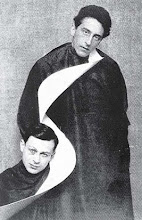Not General Grudger
It isn't that I'm entirely literal and, therefore, susceptible to being blindly obedient to others' commands, but this morning at 3:44 am, while reading Peter Graham's Classic Cheese Cookery (which Lizzie Spender, the illustrious Stephen Spender's daughter called "a delight to read and a must for insomniac browsers" in the Sunday Times), I encountered this unusual recipe for General Grudger, and felt compelled to share it with you.

I have covered Anglo-Indian cuisine here previously and probably will do so again because the recipes are so appealing and the history is so colorful. But I include this recipe (and I imagine Graham included it in his book) because it's an off-beat surprise and "conversation piece" that I think will appeal to contemporary tastes. Personally, I tend to get turned off by the sticky and often sweetened "baked brie" confections that began cropping up in restaurants and at cocktail parties about 10 years ago. The General Grudger combines sweet and savory, but also incorporates textural and flavor elements reminiscent of kedgeree and shepherd's pie. It's simple to make, almost ancient and looks worth trying.
General Grudger seems to be a baked cheese recipe with a notable difference, edge and style that could serve as an unusual, much better alternative:
GENERAL GRUDGER
"An Anglo-Indian curiosity from E.H. Parry's Cookery and Other Recipes (Allahabad, 1910), a book heavily redolent of the British Raj, with its advertisements in the front for "improved 'Cawnpore Tent Club' pith helmets, Madame E. Thick's drill skirts and Charles and Co., chemists whose 'dispensary is entirely under European control'."
The publishers interleaved the book with blank ruled pages for notes and recipes. My kitchen-soiled, battered (possibly in both senses) copy enables one to chart the itinerary of an anonymous family (diplomats? soldiers?) as they moved around the British Empire: on the interleaved pages, written in at least three different anonymous hands (grandmother? mother? daughter?) there are Australian, Indian, Singhalese and South African recipes.
Lord Wavell (l), not General Grudger
One such manuscript recipe is for General Grudger. I must confess that I have no idea how the dish came to acquire its curious name.
The 'other recipes' of the book's title include cocktails (e.g., 'P & O', 'How to keep cheese from drying in India', 'How to clean ivory knife handles', and other household hints.
For 4-6
30 g. (1 oz) sultanas
3 tbsp. milk
1 kg (2 lb 3 oz) potatoes
salt
freshly ground pepper
60 g (2 oz) unsalted butter
3 tbsp mango chutney
110 g (4 oz) freshly grated Cheddar
20 prawns cooked and shelled
3 hard-boiled eggs, shelled and sliced
4 tbsp breadcrumbs
2 tbsp good curry powder
2 tbsp fresh parsley, chopped
Put the sultanas to soak in the milk. Wash and cook the potatoes in plenty of boiling salted water until tender. Peel and mash, adding salt and pepper to taste. Butter a pie dish with half the butter. Put a thin layer of mashed potato on the bottom of the dish and follow this with layers of chutney, cheese, potato, prawns, hard-boiled egg, cheese and potato, in that order. Fry the breadcrumbs gently in the remaining butter. When crisp, add the curry powder, sultanas and parsley. Make a small well in the center of the layered pie dish and fill with the mixture. Bake in a fairly hot oven (190 C/ 375 F/Gas mark 5) for 20 minutes.
Not General Grudger; Lord and Lady Mountbatten and daughter with Nehru -- a "whole other story"
From: Peter Graham, Classic Cheese Cookery. London, Penguin, 1988, 1995.
A Colonel, not a General






































